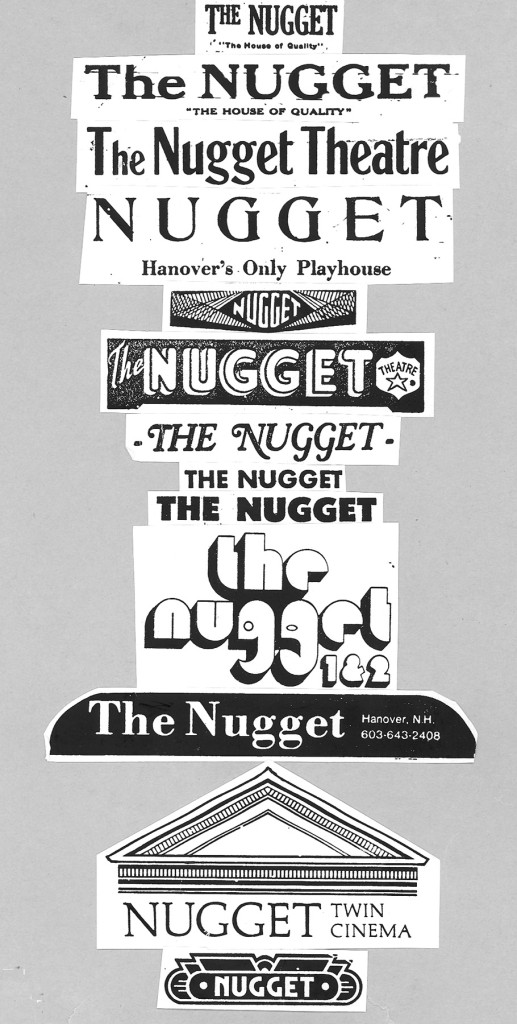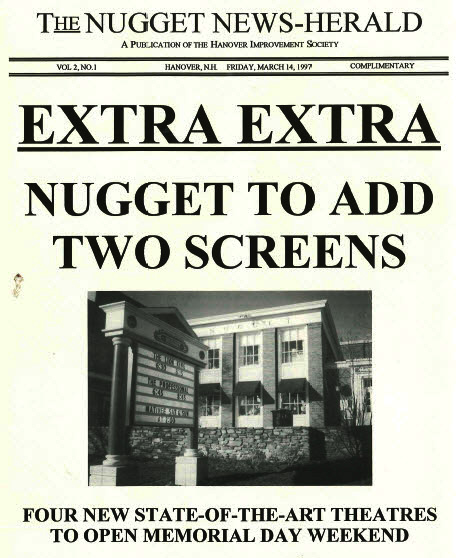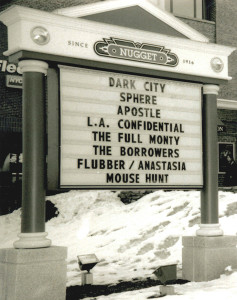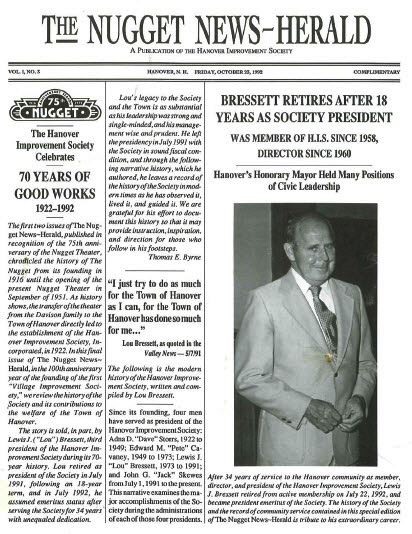The Nugget’s Long Run
Check out this editorial from the Valley News about the Nugget’s centennial:
https://www.vnews.com/Archives/2016/01/edit-nugget-vn-012716
Nugget Centennial
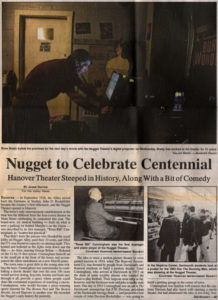 The Valley News published this article about the Nugget Centennial:
The Valley News published this article about the Nugget Centennial:
https://www.vnews.com/Archives/2016/01/a1-Nugget-seaton-vn-012416
Oscar Nominees at the Nugget
Over the last 6 years The Nugget has screened 422 films of which 129 received a total of 414 Oscar Nominations winning 98 Oscars.
3-D Comes to the Upper Valley
By Alex Hanson
Valley News Staff Writer
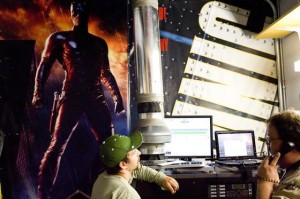
Technicians Owen Smith and Dan Devoe from Strong Technical work on upgrading the firmware of the new 3D digital projection system Tuesday afternoon, June 15, 2010. at the Nugget Theatre in Hanover, N.H. The first 3D film, Toy Story 3, will be shown on Friday. Valley News – Patrick T. Fallon
Barring anything unforeseen, this afternoon the first patrons will sit down in the Nugget Theaters’ biggest theater and enjoy the first digital 3-D screening in the Upper Valley.
The Nugget had a new digital projector installed this week, in time for the release of Toy Story 3. The film will be projected onto a new silver screen, a replacement for the white screen and a requirement for 3-D projection.
“I think the quality of what they’re going to see is a definite improvement,” said M. Kaufman, manager of the Nugget.
The Nugget’s new projector is just the first of a wave of upgrades aimed at Upper Valley eyeballs. Last week, Dartmouth’s Hopkins Center installed a new digital projector for Spaulding Auditorium that will be powerful enough to produce a proper image in the cavernous 880-seat hall. The Hop also is putting digital surround sound into Spaulding, said Sydney Stowe, manager of the Hop’s film program.
“The world is going digital and we would like to be able to present video at the same level as we present 35 millimeter,” Stowe said.
Within the next month or two, Entertainment Cinemas in Lebanon plans to install its first digital 3-D projector in the largest of its six theaters, said Bill Hanney, owner and president of the Boston-based theater chain. Hanney’s company also plans to add new theaters at the complex in Lebanon — part of a planned expansion to 10 screens — that will have digital 3-D capabilities.
A message left at the Boston-based food service company that owns Claremont Five-Star Cinema was not returned. Officials with Woodstock’s Town Hall Theatre could not be reached yesterday.
The switch to digital follows an industry imperative. Hollywood studios prefer digital projection because it lowers shipping and storage costs — 35 mm films are shipped in big cumbersome boxes, while the digital films arrive in small plastic cases. Films distributed digitally also are harder to pirate. What’s more, a digital film remains sharp throughout its run in a theater. “Every time you run a 35 mm print through a projector, it’s going to wear,” Kaufman said.
The Nugget, which is owned by the nonprofit Hanover Improvement Society, has been considering the purchase of a digital 3-D system for two or three years, Kaufman said. This year, the price finally came down enough, although Kaufman declined to reveal how much the Improvement Society spent.
The price came down because “Avatar just exploded,” Kaufman said. People flocked to the theaters to see James Cameron’s 3-D feature and more theaters purchased digital projectors. Prices dropped as companies chased the new business, which led to even greater demand. Bringing the new projector and screen online is just the first of a host of upgrades the Nugget plans to roll out this summer. The theater is updating its box office and concession stand to take credit cards, and once that’s up and running will begin to sell tickets through its Web site.
However moviegoers buy their tickets, they will pay more. Ticket prices rise today to $9 for adults and $7 for seniors, children and matinees. For 3-D films, the prices will be even higher: $12.50 for adults and $10.50 for seniors, children and matinees. The movie studios demand more money back from each ticket sold to cover the cost of converting the film to 3-D, which drives ticket prices up.
The Nugget will likely put digital 3-D in another of its theaters within the next two years, Kaufman said, a move that would allow it to open a second 3-D film while an earlier release remains in the theater.
Hollywood is touting 3-D as the future of movies, and the number of releases in 3-D is climbing steadily. Warner Bros., alone is releasing five films in 3-D this year and eight next year, Stowe said.
Although the new projector at Spaulding doesn’t have 3-D now, it will enable it in the future, Stowe said. The technical challenge the new projector meets is the size of the “throw” — 98 feet from the projector to the screen — and of the 27-foot-wide screen. For the past four years, the Hop has used a 6,000-lumen projector for digital media. Last year, documentary filmmaker Frederick Wiseman said. “Huh, this looks a little dim,” Stowe said.
“We do so few video shows,” said Stowe. The Hop screens nearly all of its films from 35 mm prints. “We’ve been able to sort of skate by for a while.”
But sometimes the Hop can’t get a 35 mm print of a film in one of its programs, and Dartmouth’s frequent tributes to screen legends include film clips assembled on DVD. Another impetus for the new 10,000-lumen digital projector came from the Hop’s screenings of the Metropolitan Opera. Saturday live broadcasts will remain in Loew Auditorium, which already has sharp digital projection and digital sound, but Sunday-afternoon encore performances will screen in Spaulding, Stowe said.
Although Hop employees were training on the new projector this week, it won’t debut until next month, when Ken Burns brings Baseball: The Tenth Inning, an addendum to his acclaimed documentary series about the national pastime, to Spaulding on July 16 and 17. After that, it will be used for the 12 opera programs and a handful of other programs.
The new projector raises questions for the Hop’s film programmers, Stowe said. The summer Dartmouth Film Series is titled “Leading Ladies,” and features films with women in central roles. There’s no public 35 mm print of the 1990 French noir La Femme Nikita, Stowe said. “Do we play it on Blu-ray,” currently the highest resolution available, she asked.
“It will look unbelievable, but people could see it in their homes,” or should the Hop scour the landscape for a private 35 mm print? Some smaller films are being released only on DVD.
In some ways, digital projection is also being driven by moviegoers, many of whom have high-definition televisions and high-definition video like Blu-ray at home, Stowe said.
“Most people who go to the movies now, they have hi-def on their TVs,” she said.
The giant screen in Spaulding might bring people out for special programs, Stowe said. Ohio State University’s Wexner Center for the Arts held a free digital screening of the final episode of Lost, and Stowe said she would love to see the Hop screen the Oscars.
As excited as they are about the new technology, both Stowe and Kaufman expressed a bit of unease.
“My initial reaction as a theater manager, my worry is, you’re dealing with more of a projector that’s a computer than you’re dealing with a film that you can have in your hand,” said Kaufman, who’s been at the Nugget for 13 years, the past three as manager. He knows how to remove damaged frames from a 35 mm film and splice it back together, but the new black box with its screen, keyboard and mouse is a bit mysterious.
“It’s a new medium and it’s so uncomfortable for me,” Stowe said. “If it goes down, how do you fix it?”
The Hop plans to continue to screen almost all of its films from 35 mm prints, and “most people feel that films will be made on 35 for another decade,” Stowe said. After that, who knows?
The beauty of the new technology will, as always, be in the eyes of those who behold it. Stowe said she got a preview of the new projector with a screening of Dirty Harry, of all things.
“You can see the herringbone weave on his blazer,” she said.
***
Alex Hanson can be reached at ahanson@vnews.com or 603-727-3219.
